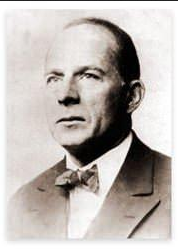Joseph Sobran discovered these Garet Garrett essays “one night, long ago, at the office of National Review, where I then worked.” As the flagship of modern conservatism, National Review supported the Cold War and the hot war then raging in Vietnam.
“Two questions occurred to me,” Sobran writes. “One: ‘Why haven’t I heard of this man before?’ Two: ‘If he’s right, what am I doing here?”
I discovered these essays at 16 in a Seattle bookstore that specialized in right-wing opinions. The bright blue paperback was called The People’s Pottage. The book was one of the twelve “candles” of the mysterious John Birch Society, though the author had died before the society was founded. In his day he had been a member of the mainstream press.
Who was Garet Garrett? He was a stylist, right from the first paragraph. His writing had an unusual clarity of belief, and the ominous tone of a man convinced that his country had been steered down the wrong road.
Garrett’s beliefs were once the stuff of conservatism, and in 1954 his obituary in the New York Times labeled him a conservative. But the positions he defended—a pre–New Deal constitutionalism, an America-first foreign policy, a gold-backed currency and economic laissez-faire—are far forward of the trenches defended today by mainstream conservatism. His belief in laissez-faire would be called libertarian today. On tariffs and immigration he anticipates the nationalist conservatism of Patrick Buchanan. On foreign policy he occupies the ground that Buchanan and most libertarians share in opposition to today’s Republican order.
In 1967 Garrett was new to me. Strangest was his essay, “Rise of Empire,” in which he argued that in undertaking to defend freedom everywhere, America had given up the Republic. The terms of this argument were conservative, but was the conclusion? My idea of a conservative was Sen. Barry Goldwater, whose policy on overseas Communism was the opposite of Garrett’s.
Who was Garet Garrett? How did he pronounce his name? The book I bought in 1967 said he had retired to a cave on a riverbank. A troglodyte indeed.
Thirty-five years later I went looking. I found a small academic biography, Carl Ryant’s Profit’s Prophet (1989), and a chapter in Justin Raimondo’s Reclaiming the American Right (1990). I found 13 Garrett books, including several of what might be called economics novels (The Driver, The Cinder Buggy), a novelistic essay (The Blue Wound), a political novel (Harangue) and an economic biography (The Wild Wheel). There were acres of journalism, much of it in the Saturday Evening Post and a forgotten magazine called American Affairs.
Scattered here and there were statements about the man himself. Garrett was five feet five and had blue-gray eyes. In 1937 his editors at the Saturday Evening Post said he had “an apparently inexhaustible supply of nervous energy and the most completely controlled and incisively logical mind we’ve ever come across.”
He was the son of a tinker, born in downstate Illinois in 1878 as Edward Peter Garrett. He grew up on a farm in Iowa and learned to direct a team of horses at age ten. Schooled only through the third grade, he educated himself by reading books.
He left home at 18, hopping a freight for Chicago. “It was a hard, unfriendly city,” he wrote. “If you were hungry, you would let it go for a long time without asking for anything, for if you asked, you were a bum.” It was there, he recounted in the Saturday Evening Post, that he hung his only shirt up to dry on a bush and the wind blew it into the river while he dreamed. Shirtless, he hopped a freight for Cleveland.
Garrett began his career as a printer’s assistant at the Cleveland Press. He soon became a reporter. During the McKinley administration he moved to Washington, D.C., where he began writing under the name Garet. The name stuck, and he legally adopted it. He pronounced it GARE-et GARE-et.
In 1900, when J.P. Morgan was putting together the United States Steel Corporation, Garrett moved to New York and became a business reporter. In The Cinder Buggy (1923), he describes the steelmen holding court with the press. He was there. During the early years of the century, he wrote pieces for investors under the pen name of John Parr. He also made a lifelong friend of Bernard Baruch, who would become a confidant of Woodrow Wilson and Franklin Roosevelt.
By 1915, when neutral America was on the sidelines of World War I, Garrett was dispensing opinions from the editorial board of the New York Times. The paper’s owner, Adolph Ochs, wanted the Times to be neutral on the war. But Garrett wrote in his journal a month after the Lusitania went down, “Over and over I protest that we are more pro-English than the English.” On February 29, 1916, he wrote, “Neutrality is so rare that I sometimes ask myself if it is not an affectation. Yet I believe in it.” He would later proclaim World War I “a total loss.”
In December 1915, the Times sent Garrett to Germany. He wrote a 10-part series and brought home an official message that Germany was willing to negotiate for peace. He met with Secretary of State Robert Lansing, who was pro-British and not interested.
In 1916 Garrett went to the Tribune. “I was impatient to do things, and it was hard to get anything done at the Times—anything new,” he wrote. After the war he left newspapers, shifting his efforts to magazines and books. In 1922 he settled in at the Saturday Evening Post, which ran his articles and serialized his books for the next 20 years.
Garrett’s early journalism was not politically flavored. As a young man, he recalled, “I took the form of government as a fact to begin with, like the fact of one’s parentage, and did not think about it at all.” After about 1920 his work took on a point of view.
Garrett believed in liberty and self-reliance, and not as two separate things. He was not eager to justify his belief. Some things just are, and liberty and self-reliance was who Americans were. Dependence on the state was an Old World idea, like the divine right of kings.
Liberty, he believed, makes the individual strong. In Satan’s Bushel (1924), he pictured an old man urging farmers to be strong like a tree. The elms, the old man says, “have no sick religion of equality. They contend with each other for advantage. What they have in common is an instinct—one way of fighting against all the other plants. That is what the farmer needs.”
Garrett also argued that liberty makes the nation strong. In The Cinder Buggy, he wrote of the first entrepreneurs of steel: “they were free egoists, seeking profit, power, personal success, everyone attending to his own greatness. Never before in the world had the practice of individualism been so reckless, so purely dynamic, so heedless of the Devil’s harvest.” Yet to prepare the nation for World War I, he wrote, “it happened—it precisely happened—that they forged the right weapons.”
There was also an egalitarian aspect. The America he remembered (and it was probably the rural America) was a place that combined self-reliance and a kind of social equality. “To be poor is no disgrace,” Garrett wrote in 1947. “In the whole civilized world that was only true here.”
Keeping the American identity justified a certain separatism. Though at home Garrett was for laissez-faire, at the border he became a nationalist. In 1920 he supported the Jones Act, the law that reserved shipping between two US ports to US crews and ships. He didn’t want America to be at the mercy of the British merchant marine. In 1924 he supported the law curtailing immigration. Immigrants, he argued, did not think like Americans.
“The new immigration is in a notable degree wage-conscious,” he wrote. “Its point of view is proletarian. Previously there had been no proletariat in this country. The word was not current in the language until after the tide of migrating humanity began to rise from the south and east of Europe. There is still in the United States no proletariat but this.”
In 1930 the Post sent Garrett to the Philippines, then a US colony, where he found “sentimental imperialists” trying to mold the Filipinos into Americans. Garrett, who made no effort to hide his belief in American ways, concluded that socially engineering the Filipino culture was not going to work. Political values are not universal. Better to concentrate on keeping our own.
On January 18, 1930, Garrett was shot. He was in New York at a high-class speakeasy—this was during Prohibition—called Chez Madelon. He was having dinner with a young woman who worked in advertising, and with another couple. He had been married twice by then, and divorced twice. He was 51.
Two masked gunmen barged in. “Ladies and Gentlemen,” one announced, “Stay where you are and keep your seats.
Garrett stood up, hands in pockets, and advanced. Here is one newspaper’s account:
“What’s this?” exclaimed the writer, in a tone that conveyed nothing except the utmost peevishness. He acted like a man bored, vexed and annoyed …
“Oh, What’s this? What’s this all about?” he repeated in the same exasperated voice … [like] an irritable executive who had just been hit by an office boy’s paper wad.
Mr. Garrett refused to take the pistol seriously. He was still advancing with an expression of contempt on his face … when the bandit pulled the trigger.”
Four shots rang out. Garrett was hit in the hip, lung, and shoulder with steel-jacketed .25 caliber rounds, one of them grazing his windpipe. Thereafter he spoke with a rasp.
The robbers fled. The police called it a bungled holdup, but not before a detective insisted on questioning Garrett on a theory that it was a crime of passion. That made Garrett so angry that he threw at the cop’s head what is described by various newspapers as a dish, a porcelain cup, or a small spittoon.
Commenting on the restaurant, Garrett said, “You get a wonderful dinner at this place, but it costs like the mischief.”
Garrett is today classified as part of the Old Right, a name given later to those who opposed the New Deal and World War II. Some were famous, such as the critic and satirist H.L. Mencken, founder of the magazine American Mercury. Others included Robert McCormick, publisher of The Chicago Tribune; John T. Flynn, author of The Roosevelt Myth (1948) and a leader in the America First Committee; and various Republicans, particularly Sen. Robert Taft.
Professionally Garrett was closest to the small band of believers in free-market economics: Leonard Read, founder of the Foundation for Economic Education; Henry Hazlitt, author of Economics in One Lesson (1946); Ludwig von Mises, who had demonstrated in 1920 that socialism had no method of economic calculation; and Mises’ pupil, F.A. Hayek, who would later win the Nobel Prize in economics and inspire Margaret Thatcher.
Garrett’s political soul mate was a literary figure, Rose Wilder Lane. She was the ghostwriter of the Little House on the Prairie books, working from outlines done by her mother, Laura Ingalls Wilder. Garrett had met Lane on the Atlantic steamer Leviathan in 1923, after his second divorce. In the summer of 1935 he and she went for a two-week drive through Midwest farm country.
William Holtz recounts in his biography, The Ghost in the Little House (1993):
She was nearing fifty now, he seven years older—short, fat and balding, with a voice husky from an old bullet wound and missing some fingers as well…. In this bed of sympathetic principle, something like love bloomed, crusty and irritable on his side, quietly supplicating on hers.
Their correspondence, preserved in the Herbert Hoover Presidential Library, is revealing, particularly of Garrett. Lane was a right-wing anarchist, more radical than Garrett, but he was the one who wrote forceful and emotional letters.
On individualism he wrote, “In principle I believe that the less we act upon the lives of others for good or evil—the less the better. Each one saves himself or he is not saved.”
In the midst of the Depression, he wrote,
I’m buying a small press on which, when the worst comes, I can print a paper of my own. I learned it when I was a printer’s devil. I can set type and run a press. Do you want a job? I could teach you the trade in a few weeks…. For the name of my paper what would you think of Cross Roads. Owned, edited and printed by me. Advertising rates: none.
A few months later he wrote, “I’m converting an old Model A into a power plant, setting up a saw rig, tinkering. There is nothing I can think of more satisfactory, by the way, than feeding wood into a buzz saw. It’s good for the dumb rankles.”
Garrett told Lane of how he talked to his neighbors about the Townsend Plan, a homegrown progenitor of Social Security. He wrote,
In my folly I was trying to prove to them that the Townsend Plan would wreck the economic scheme. What did they care about the economic scheme? They would be dead before the result. Meanwhile, $200 a month. Do you see the trouble—I was right and they were right. So with the New Deal. For those who want that kind of world it is right. For those who don’t want that kind of world it is wrong. And, again, it simply isn’t arguable.
The letters hint strongly of an affair. Garrett wrote her:
Do you know the fish—the shell fish—that has only half a shell and lives against a cliff for the other half? I can pronounce it and so can you, the name, I mean, but I cannot spell it and neither can you, unless you remember it from a bill of fare, which doesn’t prove it to be right. I cling to the cliff. Only two things can pry me off. One is death and the other is a female. That is why I hate females. I know what this strange fish is thinking. He wonders why anybody would want to pry him loose, that is, he wonders why anybody would want him to eat. It is a weak fish. The only strength he has is his weakness, his half-shellness his incompleteness. He is tough and to the refined taste coarse, but these qualities, which should be somewhat in his protection, are of no use whatever because when they are discovered it is too late, for him and for everyone else. When he dies he drops into the sea, and it was a hell of a little to have lived for, and he can’t help it …
Life is an ass. I’ve told you that. It is so in all senses, personal and impersonal.
What do I want you to do? Nothing. You are not that kind of shellfish. And if you were, what would be the use of sticking side by side to a sea cliff? And for all this I’m in a great rage at you. If we were in the kitchen I’d throw a plate at your head.
He wrote, “Rose dear, it is more than I can understand. You shake me in the fixed principle of my life. I am angry and happy. We two! We ought to be in a rowboat somewhere in the middle of the Pacific or on a distant island. I want to see you and yet I dread it.”
The correspondence breaks off in 1939 and starts up in 1953 with a less familiar tone. Garrett remarried in 1947 and stayed married. He never had children.
The three essays in this book are written late in Garrett’s life. They are a summation of his belief that his country had taken the wrong road.
The title essay Ex America is the overview. It covers the transformation of America in the first half of the century, beginning with the early radicals who “dine on fine plate and denounced success.” Here is the story of the income tax amendment (“Only the intellectuals knew what it meant”), war, FDR, the repudiation of gold, war again, inflation, foreign aid, and war again.
Viewing the world in 1950, with its atomic bomb, “octopean government” and “dim-out of the individual,” Garrett asks, would the Americans of 1900 have wanted it? No. They would not. “Then how do you account for the fact that everything that has happened … has taken place with their consent?”
He later writes, “More accurately, first it happened and then they consented.”
The most oft quoted of these essays is his attack on the New Deal, “The Revolution Was.” It is dated 1938, though there are references in it—Quisling, for instance—that could only have come after that. It was obviously too radical for the Saturday Evening Post. Garrett smuggled pieces of it into the Post—his quotation from Aristotle about “revolution within the form” begins an editorial in the Post of October 26, 1940. But it was not until two years after he was forced out of the Post and effectively blacklisted for his anti-FDR, America First views, that he found a publisher, The Caxton Printers. Caxton published “The Revolution Was” in 1944, “Ex America” in 1951 and “Rise of Empire” in 1952, and combined them in 1953 as The People’s Pottage.
What makes “The Revolution Was” so radical is not mainly its argument. It is its language. Such phrases as “capturing the seat of power” and “mobilizing by propaganda the forces of hatred” suggest a Bolshevik revolution. We do not speak this way of the Democratic Party, because it does not fit that party today. The Democrats’ (and Republicans’) main concern today is to defend and administer a territory already in their hands. It was the task of the New Dealers to capture it.
Which they did. And in doing so, they scared people.
Three months before the election of 1936, in which Roosevelt won 62 percent of the vote, the Gallup Poll asked, “Do you believe the acts and policies of the Roosevelt Administration may lead to dictatorship?” By today’s standards it is a bizarre question. And 45 percent said yes.
FDR was a divisive man. People loved him or hated him. History has largely been written by those who loved him, but there was another view, and not held only by troglodytes.
Here is one example of many: liberal columnist Walter Lippman declared in the New York Herald Tribune of May 22, 1937, a few weeks after the Supreme Court made peace with the New Deal, that Roosevelt was creating “personal government beyond anything contemplated in our Constitution or in any other constitution of a free people.” He continued, “and it can lead only, like all other personal government in the past, from arbitrariness through confusion to tyranny.” Lippmann allowed that one may argue about this or that New Deal law, but “if we look at it as a whole we must be startled to the extent to which the restraints of free government are being destroyed.”
We remember the wartime Roosevelt, those images still may be found in our coin purses. We forget the New Deal Roosevelt and his digs at the achievers of the private sector as “money changers,” “brigands,” and “economic royalists.”
We forget that in many places (including my home state, Washington) the New Dealers worked openly with Communists, and that the government had to be cleansed of Communists after the New Deal was over.
Garrett’s economic and political take on the 1930s may be read in Salvos Against the New Deal (Caxton, 2002). In “The Revolution Was,” Garrett puts economics aside and makes a purely political argument. The acts of the New Deal, a riddle as economics, formed a pattern as politics: they consistently increased government power. In the Post of February 29, 1936, he wrote: “Such a policy, impossible to acknowledge, would involve many inconsistencies of immediate policy, because the peaceable course to the seizure of great political power is a zigzag path.”
After the New Deal came the debate over America’s entry into World War II. Garrett argued that the unstated destination of Roosevelt’s path was America as an imperial power. (For his arguments, see Caxton’s 2003 collection, Defend America First.) One example is his editorial in the Saturday Evening Post of February 15, 1941, commenting on the Lend-Lease bill: “The President tells [the people] that America must put its strength forth to save Great Britain, to save China, to defend democracy of all kinds, everywhere in the world, and to destroy out of it forever the principle of aggression,” Garrett wrote. But to do that is to embrace “the fantasy to become moral emperor of the whole world.”
Garrett wanted his government to mind its own business. This is because he wanted Americans to be able to mind their own business without being taxed, conscripted or killed in other people’s causes. Garrett supported national defense. In 1940, America was threatened strategically by Germany, and Garrett urged an expensive program of rearmament. He reluctantly supported the draft. But he did not want his country to volunteer for a crusade to defeat the Germans in Europe. It was the same later on with Russia. Defense, yes. Fighting the Communists everywhere in the world, no.
His argument, presented in “Rise of Empire,” had to do with the structure of the Republic. The Republic had been designed by men wary of a standing army. It was not designed for an open-ended, worldwide struggle. That would require a different sort of government. Domestic policy would have to be subordinated to foreign policy, and civilian concerns to military concerns. Congress would have to take orders from the commander in chief. As the leader in a worldwide struggle, America would have to have “a system of satellite nations.”
In essence it would be empire, and with less control over its own fate than a republic. It would become a “prisoner of history,” ruled by fear.
Fear of what?
“Fear of the barbarian,” said Garrett.
Half a century later, we live in that world.
Not entirely, perhaps. Military spending has shrunk as a share of total output. Wartime price controls and rationing are gone. Conscription is gone. The Communists are gone as a serious rival.
But war is not gone. As I write, American troops have conquered Afghanistan and Iraq. They are in Central Asia, in the Philippines, in Bosnia-Herzegovina and in Haiti. They are still in South Korea.
Fifty years after “Rise of Empire,” Americans begin reluctantly to recognize that their country is an empire, whether they like it or not. A young British historian, Niall Ferguson, advises them to get used to it. Garrett’s forebodings in “The Revolution Was” and “Ex America” appear to have weathered less well. State ownership of industry has been rolled back around the world. Even socialist parties now embrace a kind of market economy. Americans did not, as Garrett feared, “make the government the great capitalist and entrepreneur.”
In mid-century it appeared that the big entrepreneur would wither away, replaced by men in gray flannel suits.
But the human face of industry is back. And in their companies, the new owners have largely kept the government and the unions out.
Federal power, however, has not declined. It has metastasized, letting go of price and production decisions but placing its hands on things more politically useful. By what Garrett called the “extreme and fantastic extension of the interstate commerce clause”—a hole in the Constitution opened during the New Deal—government now compels private employers to prefer one race of job applicants over another. It wages a War on Drugs. It decrees that no American shall sell a toilet tank with capacity greater than 1.6 gallons.
And how fares self-reliance? Better here than in Europe, but worse than in Asia. Self-reliance in the new America is not what it was.
Garrett died a saddened man.
“Those who remembered Garrett in his later years recalled him as an interesting, colorful, and individualistic person who erected a gruff exterior to protect his inner sensitivity,” writes Ryant, his biographer.
Partially bald, he seldom went to the barber or worried about his appearance in general. He wore bow ties that matched the color and material of his shirts, often in vivid, solid tones. At times, he forgot to wear a tie. He wore baggy pants and tweed coats that were old and ragged at the elbows. Yet his handmade shoes were shined daily—sometimes two or three times a day for special occasions. He was stout and red in the face… Somewhat profane, he was a slow and meticulous writer. He chain-smoked cigarettes and loved good bourbon, particularly Virginia Gentleman. At home, he was a do-it-yourselfer, the type who fell out of an apple tree while pruning it.
Richard Cornuelle, who worked for Garrett beginning in 1949, recalls, “He was a small, impish, elegant man with a Gilded-age mane of flowing white hair. He dressed in tailored tweeds, wore a black Borsolino and carried a cherry-wood walking stick.”
By then, Garrett was considered an elder of conservatism. “That characterization fit him badly,” Cornuelle writes,
and he was more often than not embarrassed by his following. When one or another of his hot-eyed adherents came looking for him in the office, he would hide between the stacks in the library, smoking restlessly… “What would he do,” he once asked me about one of these soapbox apostles of free enterprise, “if he won?”
When Garrett worked on an essay, he would read and think for hours. “Then, suddenly, he would seize an old-fashioned pen holder, jam a new point into it, and scrawl on white foolscap, often for hours, panting and sweating,” Cornuelle describes. “Then he’d howl impatiently for Kelly, his secretary, and dictate what he’d written while he could still read it.”
And the cave? “Once when he was near death’s door, a girlfriend—Dorothy something—kept him alive by making his bed over and over,” Cornuelle writes.
When he had somewhat improved, she tore the necessary pages out of the yellow phone book and prayed for his survival in every church in Detroit. He told me, “You can’t not marry a woman like that.” But she was an alcoholic and a pest, so he built a cement-block study near the river about fifty yards from the house. It had insulation and heat and water, but no toilet. When I asked him why, he said, “I want to go home that often.” He called it “the cave.”
Cornuelle recalls sitting with Garrett “mornings on the screen porch of his house on the Tuckahoe River during his last year, scratching and yawning and talking…. He was mourning a society that had first showed so much promise and now seemed so surely doomed.”
In June 1954, Baruch wrote that he had reread Garrett’s 1928 book An American Omen, which had celebrated modern management, automation, and high wages. Garrett replied, “I wish I could be as optimistic now as I was then. I am not very deaf, but my legs are not as stout as they used to be. I have just sold another book, and that means I am still going.”
It was his last book, The American Story, a delightfully opinionated history now out of print. In A Life With the Printed Word (1982), John Chamberlain remembered Garrett vowing to hang on until he finished this book. Garrett said, “You can’t die while you are still mad.” Garrett finished it and died, fifty years ago this year [2004].
Cornuelle writes that Garrett left “several thousand silver dollars buried in buckets under the porch, a remarkable collection of books and a tangled jumble of papers.”
Dorothy Garrett, who died a year later, offered his papers to Harvard. “The Houghton Library sent a few first editions and an apprentice in library science,” Cornuelle writes, who “carried away a few first editions and a handful of letters signed by such celebrities as Hoover and Baruch, and left the rest behind.”
After Dorothy died, Garrett’s remaining papers were sold off in bundles with his kitchen pots and bed linen.
This article is excerpted from the introduction to Ex America, by Garet Garrett.
Full story here Are you the author? Previous post See more for Next postTags: Featured,newsletter

























